Social networks and instant messaging apps rise and fall in popularity. In the midst of all of that activity, one computer-based communication tool remains supreme: email. With an estimated 269 billion emails being sent every day, it’s by far the most-used way we speak to each other on the web. How many do you receive?
Microsoft Outlook is a popular email client. It can do it all—organizing your messages into folders and categories, putting junk mail out of sight, and allowing you to send individual messages to your calendar or task list.
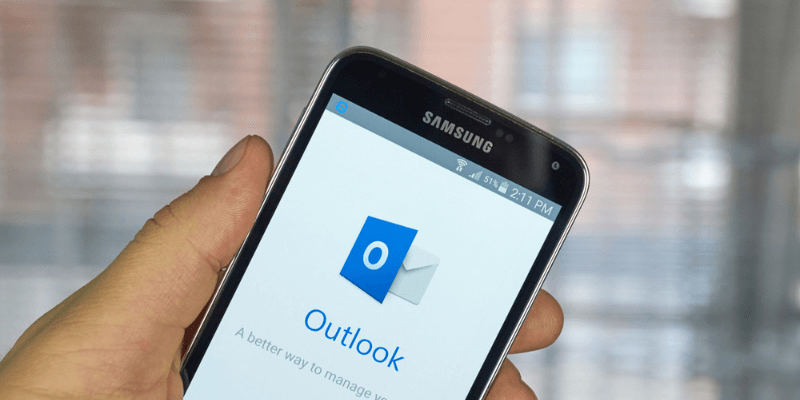
But it’s not your only choice, nor is it the best program for everyone. Should you use Outlook or find an alternative? Read on to learn where Outlook excels and where it doesn’t, other available software options, and whether they’ll better suit your needs.
Table of Contents
Top Alternatives to Microsoft Outlook
1. Mailbird (Windows)
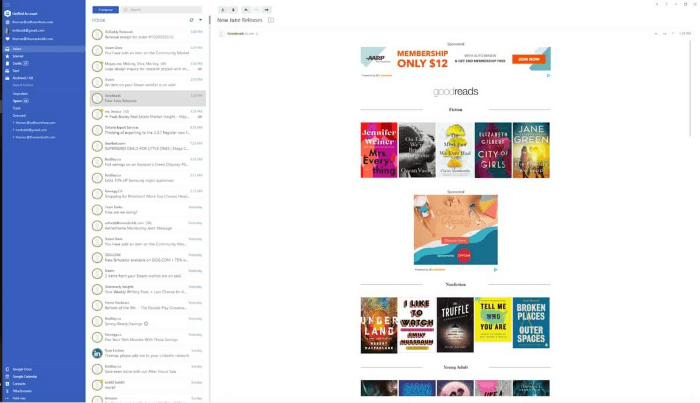
Mailbird is a Windows email client that’s stylish and easy to use (a Mac version is currently in development). It’s the winner of our Best Email Client for Windows roundup and was covered in-depth in our Mailbird review. We also have a more thorough comparison of Mailbird vs Outlook, check it out.
Mailbird is currently available for Windows only. It’s available for $79 as a one-off purchase from its official website or a yearly subscription of $39.
While Outlook offers ribbons full of icons and an advanced feature set, Mailbird aims to free you from distractions with a minimal interface and an easy-to-use app. It helps you to efficiently work through your inbox by offering features like snooze and send later.
Folders and search will help you manage your email. However, rules that automatically sort your mail and advanced search terms are not offered. It also won’t check for spam—it relies on your email provider for that. Mailbird does block remote images, though, and integrates with tons of third-party apps and services.
If you’re a Windows user and spend most of your time in your inbox, Mailbird is a terrific alternative to Outlook.
2. Spark (Mac, iOS, Android)
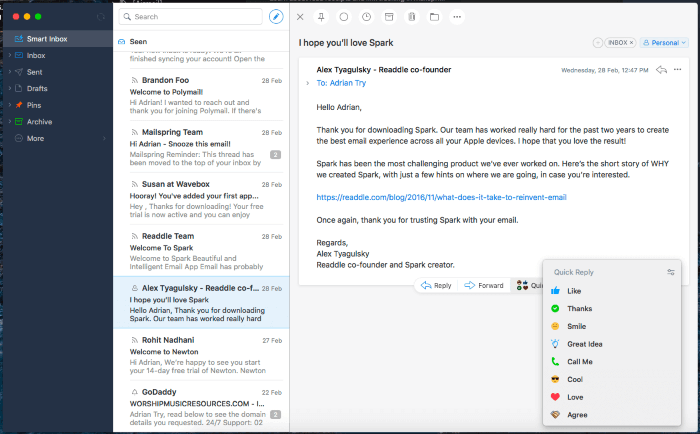
Spark is currently my personal favorite email client. It’s available on Mac, iOS, and Android. Like Mailbird, it focuses on ease-of-use and efficiency, and we found it to be the easiest email client in our Best Email Client for Mac roundup.
Spark is free for Mac (from the Mac App Store), iOS (App Store), and Android (Google Play Store). A premium version is available for business users.
Spark offers a streamlined interface that helps you see, at a glance, the emails that are most important so you can deal with them quickly. A Smart Inbox view separates unread mail from read, real messages from ads, and flagged (pinned) messages from unpinned. The app only displays a notification when a mission-critical email arrives.
Quick Reply lets you send a simple response with a single click. Like Mailbird, you can snooze and schedule emails. Configurable swipe actions allow you to quickly act on an email.
Messages can be organized using folders, tags, and flags, but not automatically—you can’t create rules. Advanced search criteria allow you to narrow down your search results accurately, while its spam filter removes junk messages from view.
If you’re a Mac user and prefer a responsive, efficient email client, take a close look at Spark. It’s the Mac user’s alternative to Mailbird, though it’s a little more robust.
3. eM Client (Windows, Mac)
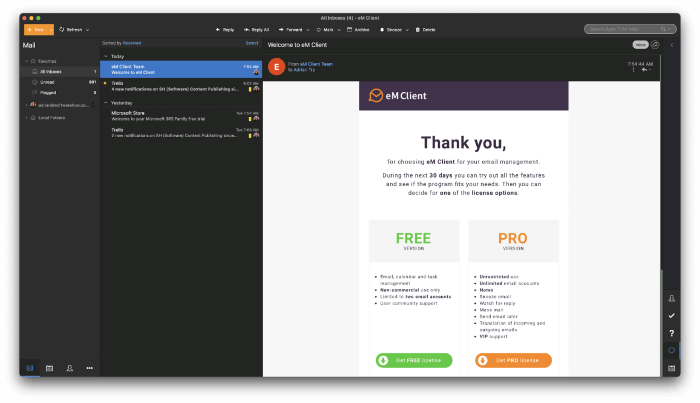
eM Client offers a good balance between the power of Outlook and the minimalism of Mailbird and Spark. It’s available for both Windows and Mac. We cover it in a full review and we also compare eM Client vs Outlook in greater depth.
eM Client is available for Windows and Mac. It costs $49.95 (or $119.95 with lifetime upgrades) from the official website.
eM Client will feel familiar to Outlook users. Its menu structure and terminology are very similar—but it offers a much less cluttered interface. While it has much of Outlook’s power, it also aims to help your inbox workflow. For instance, it allows you to snooze incoming emails and send outgoing ones later.
This client includes many of Outlook’s advanced features. You can organize your messages by folder, tag, and flag, and add automation via rules. However, eM Client’s rules don’t allow you to do as much as you can with Outlook. The app’s search and search folder features are, however, on par with Outlook’s.
eM Client will filter out spam and block remote images. It also provides email encryption for sensitive messages, a feature only a subset of Outlook users can access. Like Outlook, an integrated calendar, task manager, and contacts app are available. Outlook’s library of third-party add-ins allows better integration with other services, though.
If you want the power of Outlook without the clutter that goes along with it, check out eM Client. It has a more modern interface and better tools for working through your inbox.
4. Airmail (Mac, iOS)
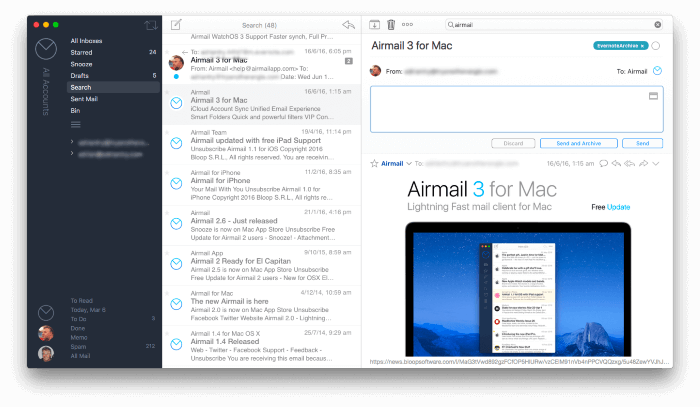
Airmail is a fast and attractive email client for Mac and iOS; it won an Apple Design Award. Like eM Client, it gives a solid balance between ease of use and power. You can learn more about it in our Airmail review.
Airmail is available for Mac and iOS. The basic features are free. Airmail Pro costs $2.99/month or $9.99/year. Airmail for Business costs $49.99 as a one-time purchase.
Airmail Pro includes many of Spark’s workflow features, such as swipe actions, a smart inbox, a unified inbox, snooze, and send later. It also offers many of Outlook’s advanced features, including top-notch sorting and searching, email filtering, and automatically acting on emails via rules.
Like other apps, it supports folders, tags, and flags—but it goes further. You can also mark emails as To Do, Memo, and Done, and use Airmail like a barebones task manager.
Finally, instead of trying to do it all, Airmail offers excellent support for third-party apps. It’s easy to send an email to your favorite task manager, calendar, or notes app.
5. PostBox (Windows, Mac)
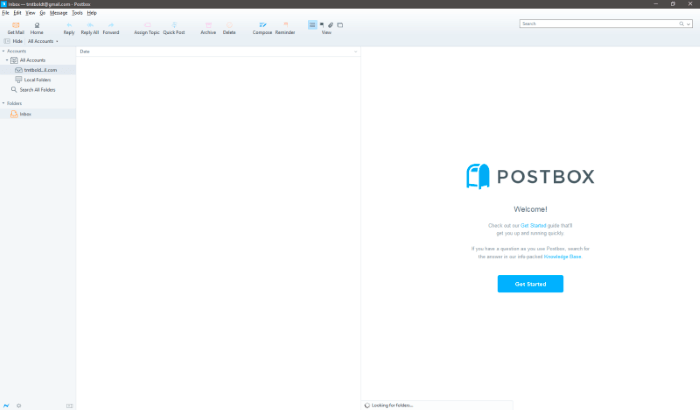
If you prefer power over ease-of-use, PostBox may be the Outlook alternative that you’re looking for.
Postbox is available for Windows and Mac. You can subscribe for $29/year or purchase it outright from the official website for $59.
Postbox offers a tabbed interface, allowing you to have several emails open at once. Searching is fast and effective, and you can search for files and images in addition to email content. You can mark some folders as favorites for quicker access. Encryption is provided through Enigmail.
Email templates speed the creation of new emails and include reformatted clips and a signature manager. You can customize the interface and layout to suit your workflow and extend its functionality through Postbox Labs.
But it’s not just about power—many usability features are also offered. You can filter email with a single click and take quick action on emails with a few keystrokes using the Quick Bar.
Because Postbox is designed for advanced users, it leaves much of the customization to you. It doesn’t block remote images by default. Similarly, you may need to perform additional steps during the setup stage. For example, before adding a Gmail account, you need to enable the IMAP protocol.
6. MailMate (Mac)
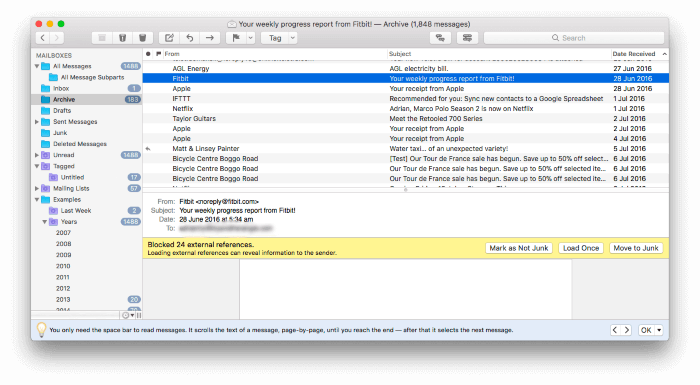
MailMate is another Mac app for power users, and this one is even geekier than Postbox. It’s keyboard-centric and text-based, choosing function over style and ease-of-use. We named it the most powerful email client for Mac.
MailMate is available for Mac only. It costs $49.99 from the official website.
Email is an ancient technology. The only consistent standard for formatting is plain text, so that’s what MailMate uses. Markdown is the only way to add formatting to your messages, making it unsuitable for some users. Like Outlook, MailMate offers Smart Folders, but they’re on steroids. More complicated rules will automatically filter your mail.
Amid all that power, you’ll still find lots of conveniences. Email headers are clickable. If you click on a name or email address, all of the emails from that person will be displayed. Click on a subject line, and all emails with the same subject will be listed. Clicking on more than one item will filter by all of them.
MailMate isn’t for everyone. It doesn’t support Microsoft’s Exchange protocol, for example. Exchange users will be better off with Outlook.
7. The Bat! (Windows)
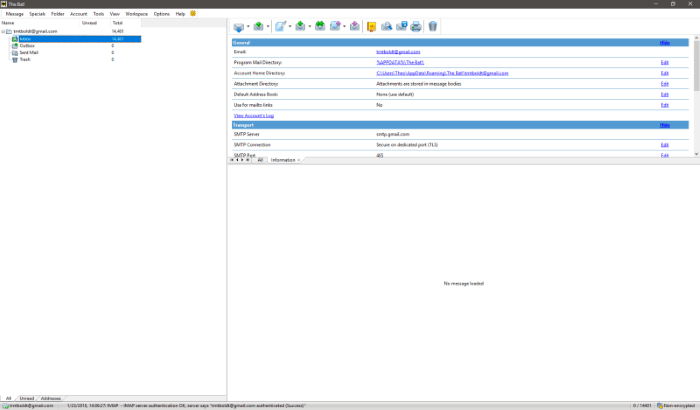
The geekiest email client for Windows users is The Bat!. This one’s as much about security as it is about power. It’s not as user-friendly as the apps earlier in our list. However, it supports several encryption protocols, including PGP, GnuPG, and S/MIME.
The Bat! is available for Windows only and can be purchased from the official website. The Bat! Home currently costs 28.77 euros, and The Bat! Professional costs 35.97 euros.
I first heard of The Bat! A couple of decades ago, in a Usenet group that discussed the most powerful applications for Windows, such as file managers, scripting languages, and email clients. Those types of power users are still the target group—everyone else will be better served by an alternative.
Any number of email addresses can be set up. The MailTicker is a configurable notification bar for your desktop. It keeps you up to date with any incoming emails you care about.
Besides encryption, other power features include its filtering system, templates, safe handling of attached files, and RSS feed subscriptions.
8. Canary Mail (Mac, iOS)
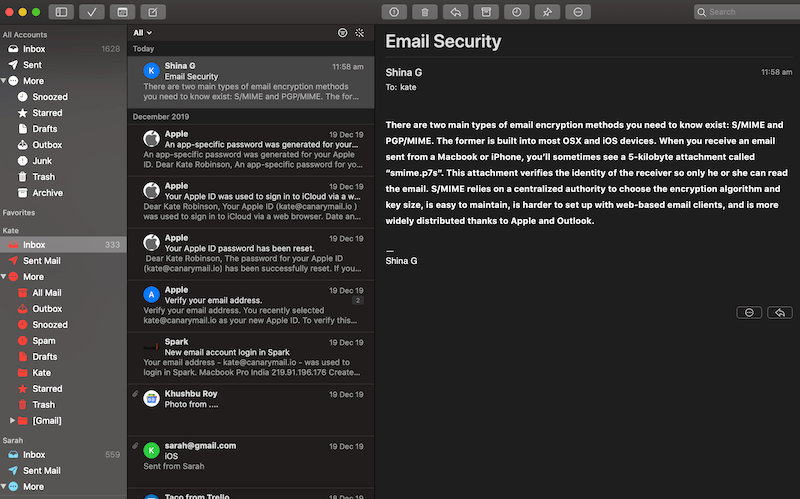
Staying with the theme of security, Canary Mail is one of the safest alternatives on our list. It’s available for Mac and iOS and is coming soon to Android.
Canary Mail is available for Mac and iOS. It’s a free download from the Mac and iOS App Store. The Pro version is a $19.99 in-app purchase. You can also get it from Setapp for $9.99/month along with many other paid Mac apps.
Like The Bat!, Canary Mail has a strong focus on encryption and is also easier to use. Other features include snooze, smart filters, identifying important emails, templates, and natural language search.
9. Unibox (Mac)
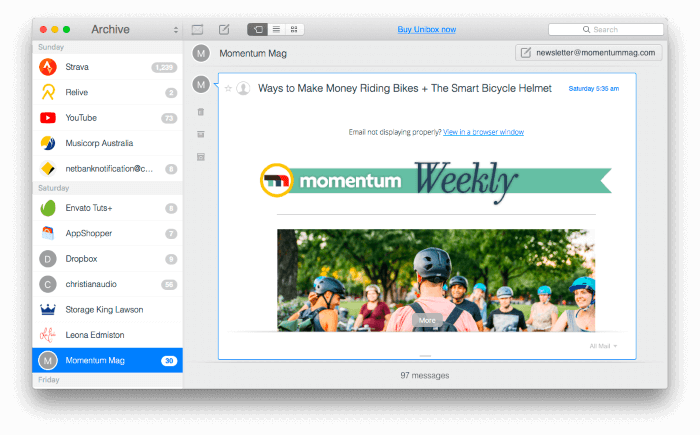
Unibox is quite different from the other email clients on our list. It departs from the usual way of doing email to become more familiar to those who grew up doing chat.
Unibox costs $13.99 in the Mac App Store.
How is Unibox different? Instead of listing your emails, it lists the people who sent them, along with a helpful avatar. Clicking on a person will display your current conversation with them, formatted like a chat app. When you click on the bottom of the screen, you’ll see all of the emails relating to them.
10. Thunderbird (Mac, Windows, Linux)
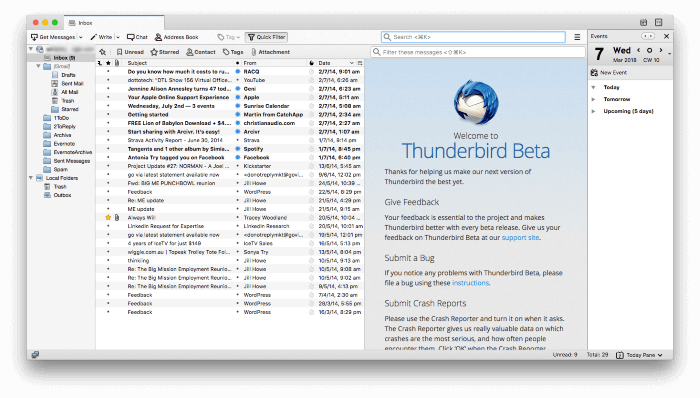
Finally, Mozilla Thunderbird is the best free alternative to Outlook, matching it almost feature-for-feature, minus the Microsoft integration.
Thunderbird is free and open-source and available for Mac, Windows, and Linux.
It’s not the most attractive application on our list, but it is one of the most functional. Like Outlook, it uses folders, tags, and flags to organize your mail, as well as rules for automation. Search criteria and smart folders are also similarly advanced.
Thunderbird scans for spam, blocks remote images, and (with an add-on) will also encrypt your email. A wide range of add-ons is available to extend the app’s functionality and integration with other services.
If you need a free alternative to Outlook and don’t need the tight integration with Microsoft Office, Thunderbird is it.
Quick Overview of Microsoft Outlook
Let’s first have a brief look at Outlook. What does it do right, and why would you look for an alternative?
What Are Outlook’s Strengths?
Supported Platforms
Outlook is available everywhere you need it: desktop (Windows and Mac), mobile (iOS, Android, and Windows Phone), and even the web.
Ease of Setup
Like many modern email clients, Outlook is easy to set up. Once you provide your email address, your server settings will be automatically detected and configured. Microsoft 365 subscribers won’t even need to supply an email address.
Organization & Management
Many of us receive dozens or even hundreds of emails a day, with an archive of tens of thousands. Outlook does a great job of keeping you above the fray.
With Outlook, you can organize emails using folders, categories (tags), and flags. To save time and effort, you can create email rules that automatically act on certain messages. You can move or forward them, set categories, display notifications, and more. Need every message from your boss piped to the top of your inbox automatically? Outlook can do it.
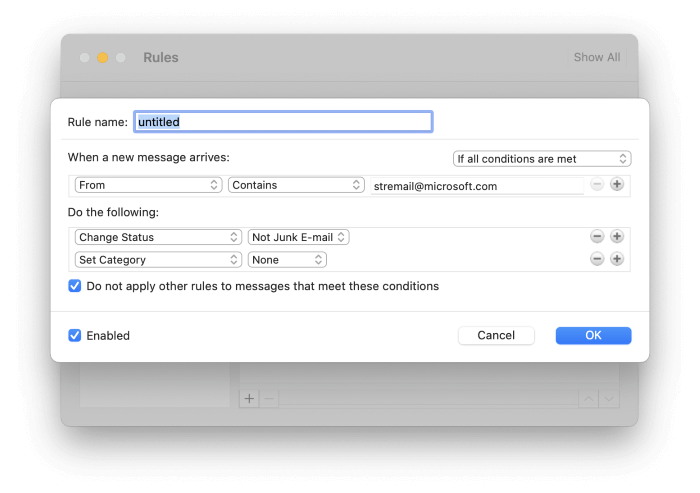
Search in Outlook is similarly sophisticated. While you can perform a simple search for a word or phrase, complex search criteria can be defined. If you need to routinely perform a particular search, Smart Folders can be created to automatically show the messages or files you need.
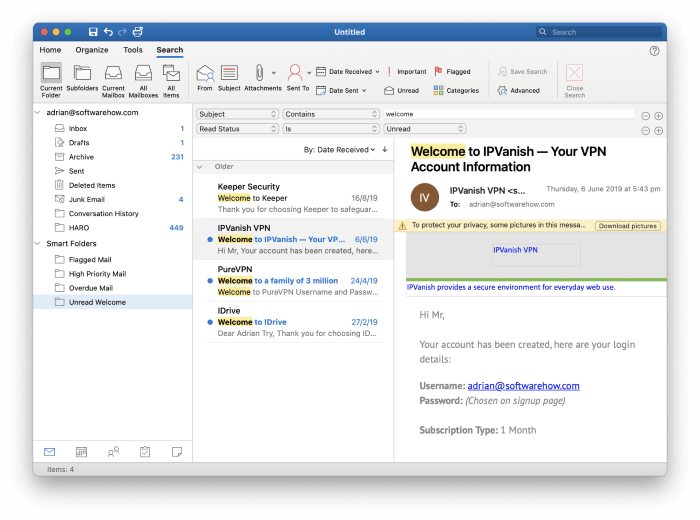
Security and Privacy
Outlook will automatically detect junk mail and move it to a special folder. You can also let the program know manually if a message is spam or not, and it will learn from your input.
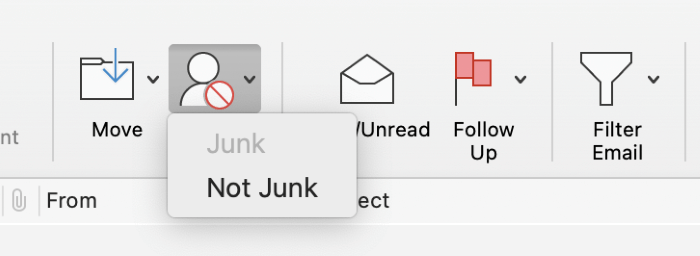
The app will also protect you from spammers by blocking remote images. Remote images are stored on the internet rather than in the message body. They’re often used to detect if you actually looked at an email. If you view the images, that will let the spammers know your email is genuine, leading to more spam.
Integrations
Outlook is tightly integrated into Microsoft Office and offers a calendar, task manager, contacts app, and notes module.
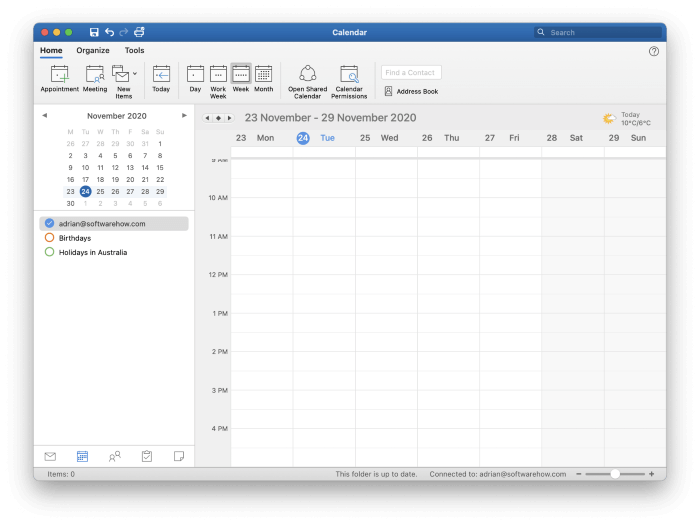
Many third-party services are keen to take advantage of Outlook’s popularity and add integration through add-ins.
What Are Outlook’s Weaknesses?
User Interface Limitations
Outlook’s Office integration and familiar interface are perfect for those who work in a Microsoft environment. However, it may feel out of place if you work with other software, and its integration (if any) won’t be as tight.
It also lacks features found in email applications that focus on efficiently handling your inbox. For example, it doesn’t let you snooze an email or schedule an outgoing message to be sent at a later date or time.
Email Encryption
Some email clients allow you to encrypt outgoing email. This is a valuable feature when sending a sensitive email, and it requires some advance setup for both sender and receiver.
Unfortunately, not all versions of Outlook can do this. It’s only available to those who use the Windows client and subscribe to Microsoft 365.
Cost
Outlook is more expensive than most email programs. It costs $139.99 as an outright purchase from the Microsoft Store. It’s also included in a Microsoft 365 subscription costing $69/year.
However, if you’re already a Microsoft Office user, the app will already be installed on your computer. You could almost think of it as being free.
So What Should You Do?
Microsoft Outlook is a fantastic email client. If you use Office, it’s already installed on your computer. Outlook works well with other Microsoft applications and third-party services and provides many advanced features.
If you prefer a program that’s easier to use, consider Mailbird on Windows and Spark on Mac. They are attractive apps with a minimal interface, focusing on eliminating distractions so you can process your inbox efficiently. Mac users who wish email was more like instant messaging should check out Unibox.
For a little more power, eM Client (Windows, Mac) and Airmail (Mac) attempt to achieve a balance. Their interfaces are less cluttered than Outlook’s as they try to offer the best of both worlds: efficiency and power.
Power users may prefer the extra functionality of PostBox (Windows, Mac), MailMate (Mac), or even possibly The Bat! (Windows). These apps sacrifice ease of use to provide more flexible search criteria and automation.
Finally, if you want a free alternative, Mac users should take a look at Spark. Another free option, Thunderbird, offers close feature-parity to Outlook on most platforms.
